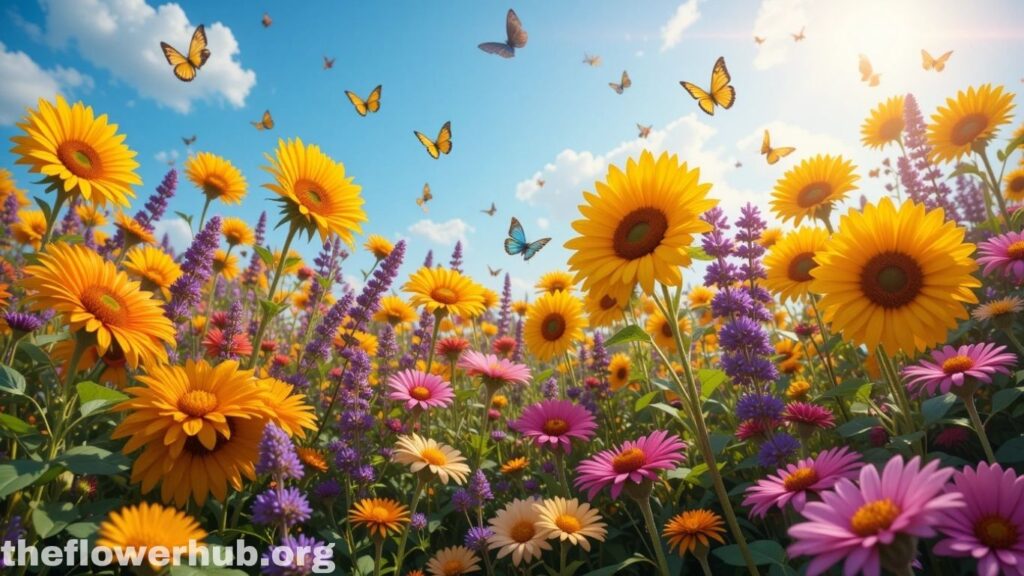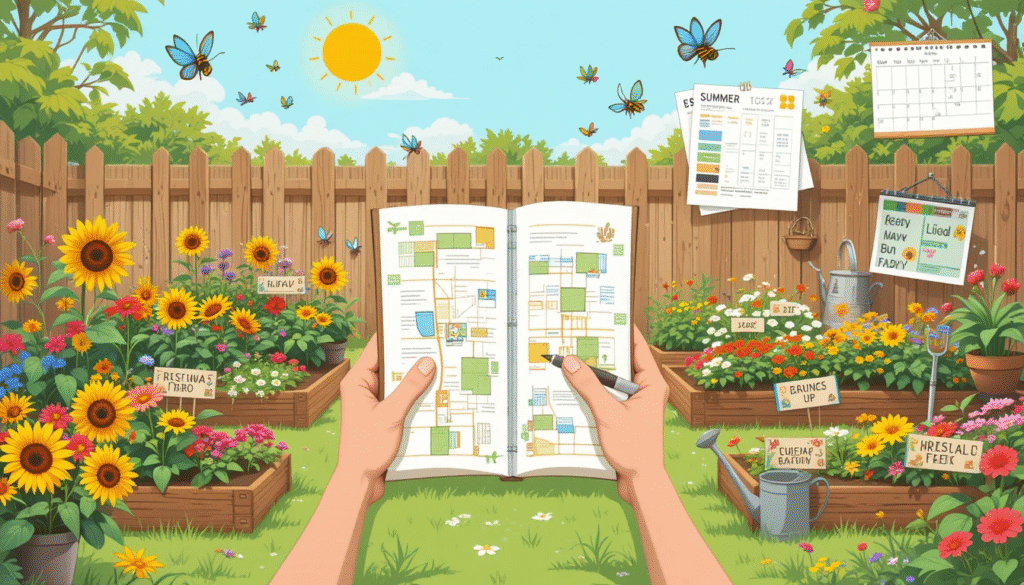Introduction
The splendor of color explodes when the soft warm sunshine wafts through the meadows. There is nothing like those summer flowers to add life, color, and cheer to gardens, porches, and patios around the world. From the bright sunflower to the dainty petunia, they represent the vigor and enthusiasm of the time of year.
In this ultimate guide, we’ll take a closer look at 10 stunning summer flowers, the type of features to look for, how to care for them and how to create a garden that blooms throughout the hottest months.

Table of Contents
Table: Overview of 10 Popular Summer Flowers
| Summer Flower | Botanical Name | Best growing zones | Signature Feature | Exposure |
|---|---|---|---|---|
| Sunflower | Helianthus annuus | 2–11 | Big, cheerful flowers | Full sun |
| Zinnia | Zinnia elegans | 3-10 | Tons of blooms | Full sun |
| Marigold | Tagetes | 2–11 | Repells pests | Full sun |
| Petunia | Petunia × hybrida | 9–11 | Wide color range | Full sun to part sun |
| Hibiscus | Hibiscus rosa-sinensis | 5–11 | Large, tropical flowers | Full sun Clip off spent blooms for re-bloom. |
| Dahlia | Dahlia pinnata | 8–10 | Complex, layered petals | Full sun to partial shade |
| Lavender | Lavandula | 5–9 | Fragrant foliage | Full sun Not sure which zone you live in? |
| Cosmos | Cosmos bipinnatus | 2–11 | Faded, daisy-like blossoms | Full sun |
| Lantana | Lantana camara | 8-11 | Color changing flowers | Full sun . |
| Salvia | Salvia splendens | 8–10 | Spikes Purple or red | Full sun |
Why Choose Summer Flowers for Your Garden?
No summer garden would be complete without an explosion of seasonal flowers. Summer flowers provide not just a burst of color, but also support for the local ecosystems by attracting bees, butterflies, and hummingbirds. Tolerant of heat and drought, they are perfect for low maintenance, sustainable landscaping.
Sunflowers: The Emblem of Summer Blooms
About Sunflowers
Sunflowers may be the most iconic of all the summer flowers. Their long stems and giant yellow heads are emblems of optimism and warmth.
Care Tips
- It is best to plant it where it will receive at least 6-8 hours of sunlight per day.
- Water often, particularly in dry periods but do not outwater.
- Support the tall forms to prevent wind damage.
Zinnias: The Ultimate No-Fuss Flower
So Why are Zinnias Good for Summer?
Zinnias prefer full sun and are very heat-tolerant. They produce bold color all season long, so they’re enjoyed by summer flower lovers everywhere!
Growing Zinnias
- Sow directly in garden beds after last frost.
- Deadhead faded blooms to promote repeat flowering.
Marigolds: A Garden Essential
Features of Marigolds
Marigolds are one of the most dependable of summer blooms, vaunted not just for their pest-repelling qualities, but also for their vibrant shades of yellow-orange.
Planting Tips
- Best grown in a well-drained soil.
- Need little or no fertilization; can retard flowering if too much is used.
Petunias: A Splash of Color
Why Petunias Shine in Summer
Petunias: Sold in nearly every color, petunias are versatile summer flowers, ideal for containers, window boxes and hanging baskets.
Caring for Petunias
- Continual deadheading will prolong blooming more.
- Base with water to avoid fungi.
Hibiscus: Tropical Flair on Hot Days
Hibiscus Highlights
Hibiscus flowers are large and bold, making them the perfect choice for adding a tropical feel to your summer blooms.
Growing Conditions
- Best in fertile, well-drained soil.
- Shelter from the wind; flowers may be fragile.
Dahlias: Garden Showstoppers
All About Dahlias
Dahlias are sought after for their intricate petal formations and variety of colors. These summer flowers are a bold highlight for beds and borders.
Tips for Success
- plant tubers once the threat of frost is over.
- Stake taller cultivars early to avoid damage.
Lavender: A Perfect Combination of Scent and Beauty
Lavender’s Summer Appeal
Lavender Few summer flowers smell as nice as lavender. It is aesthetically pleasing, it smells wonderful, and you can harvest it to use for sachets and teas and oils.
Care
- Grows well in sandy, well-drained soil.
- Prune lightly after blooming to shape.
Cosmos: The Cottage Garden Sweetheart
Why Gardeners Love Cosmos
Cosmos are open and dainty, light and airy, summery flowers that lend a natural feel to the garden, as if landscaped by a meadow.
Easy Growing
- Drought and heat resistant and does well in poor soil.
- Self-sows easily for future years.
Lantana: Color Shifters
Unique Features
The flower color of Lantana evolves as it ages, so from one plant you can get a multi-hued display — a rarity among summer flowers.
Care
- Drought hardy once established.
- Great for butterfly gardens.
Salvia: Bold and Beautiful
Salvia’s Summer Strength
With its vertical spikes and bright colors, salvia is one of summer’s standout flowers, both in terms of beauty and ability to attract pollinators.
Maintenance
- Low irrigation once established.
- Deadheading will promote a longer and all-over flowering season.
How to Plan a Summer Flower Garden

Design Tips
- Select a variety of heights, colors and times of blooms for visual interest.
- Plant similar plants together with same water and sun needs.
- Include both perennials and annuals for variation and long-lived blooms.
Watering & Maintenance
- Water deeply and infrequently to encourage deep roots.
- Mulch around plants to retain moisture and control weeds.
Common Challenges with Summer Flowers
| Problem | Cause | Solution |
|---|---|---|
| Wilting | Under watering or root problems | Increase water, if frequent check drainage of soil |
| Yellow Leaves | Overwatering or lack of nutrients | Adjust watering, feed balanced fertilizer |
| Pests (aphids, spider mites) | Hot, dry weather can bring pests in | Use insecticidal soap, introduce beneficial insects |
FAQs
What summer flowers are the best pollinator attractors?
Leilani Ledbetter, a spokeswoman for the Seed Racks, a consortium of 26 companies that sell seeds for backyard gardens, said sunflowers, salvia, lavender and lantana are among the most effective nectar plants for bees, butterflies and hummingbirds.
Do summer flowers do well in drought?
Yes, many summer plants, such as lantana, cosmos and lavender, are drought-tolerant once they are established.
What is the best time to put out summer flowers?
Transplant after last frost in your region. Whether you are planting seeds or young plants in the garden, they should be that in the ground when soil temperatures remain reliably warm.
Is there a way to prolong blooming in my summer flowers?
Deadheading regularly, feeding properly and watering consistently are factors that can help a lot of summer flowers continue to bloom from late spring to early autumn.
Are summer flowers full sun?
Many types of summer flowers perform best in full sun (6 or more hours per day), but those labeled as partial-sun flowers, such as petunias, are able to tolerate some shade.
Conclusion
Few things bring more satisfaction than a garden filled with summer flowers. These heat-loving plants can bring such vibrant color and delightful fragrance, and support for pollinators. By selecting the right varieties for your climate and tending them with attention, you can have a garden that thrives even on the hottest days.
Lush summer flower gardens Start planning your summer flower garden now — and let nature’s palette lushify your outdoor space into a warm-weather wonderland!
